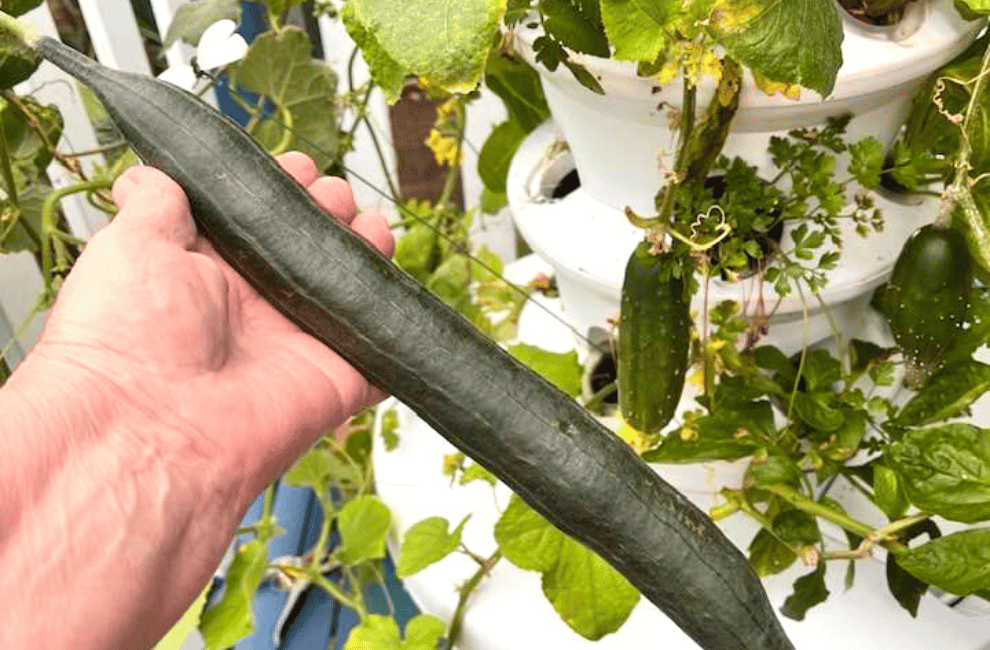
What Can You Grow With Aeroponics?

Aeroponics is a highly efficient, sustainable and simple method of growing plants, whereby roots are suspended in open air and are irrigated periodically with nutrient-rich water. One of the many benefits of growing with aeroponics, is that you can grow a huge variety of herbs, leafy greens and vegetables.
With the Airgarden’s vertical aeroponic system, there are 150 different herbs, fruits, vegetables, and edible flowers that you can grow in just 1 metre² of space. As a rule of thumb, the only real exceptions are root crops—such as carrots and potatoes—grapevines, bushes and trees.
Growing With Aeroponics
Aeroponics is a sustainable way to grow huge yields (in fact, aeroponics has been proven to grow plants 3X faster than those grown in soil) in small spaces with minimal effort, which makes it a great option for growing your own produce at home.
The absolute best plants to grow in your household and the success of harvests will ultimately depend on climate, quality of seeds, and ongoing maintenance (check out our guide to growing climate zones for more information), however there are some types and varieties of plants that typically thrive in an aeroponic system.
Growing Fruits
Many fruits, such as bananas, cherries, and apples, grow on trees, which makes them incompatible with most aeroponic systems. However other fruits, such as strawberries, melons, and blueberries, grow on vines and bushes, and can grow nicely in an aeroponic system.
The most commonly grown fruits in aeroponics are:
- Melons and watermelons: Melons and watermelons grow well in an aeroponic system if they have sufficient space and support to spread and grow their large vines. However, optimal flavour and yield results can be difficult to achieve for home growers. Melons also use a lot of water, so can reduce the water-efficiency of your aeroponic system.
- Strawberries: Strawberries take a long time to grow (typically between 10-12 weeks from seed to first harvest), but the delicious fruits can be well worth the wait!
- Blueberries: Blueberries can be grown year-round in an aeroponic system, however they do require high acidity and 60-75% humidity – conditions that would likely kill most other plants. As such, unless you fill your aeroponic system entirely with blueberries, growing them is likely not feasible.
Growing Leafy Greens, Lettuces & Microgreens
Aeroponic systems, particularly those well suited to small spaces like the Airgarden, are ideal for growing leafy greens and lettuces and typically produce superior results in terms of harvest yield and nutrient density.
Leafy greens and lettuce can typically be grown year-round in an aeroponic system, although some varieties are cool-climate crops and can bolt prematurely in summer.
One of the key benefits of growing leafy greens and lettuces yourself in an aeroponic system is that they have a short shelf life, so being able to pick what you need using the ‘cut and come again method’ eliminates food waste and maintains maximum flavour and nutrition (compared to supermarket produce that can take up to 14 days from farm to the shelf) – no more sad wilted greens in your fridge!
Leafy greens and lettuce also love the aeroponic environment, and grow so quickly that they can be ready to harvest within just 21 days of being planted from seed.
The most commonly grown leafy greens, lettuces and microgreens grown with aeroponics are:
- Chard, kale, spinach and mustard greens
- Lettuces of all kinds (e.g. cos, iceberg, buttercrunch, red oak and rocket)
- Asian greens
- All types of cabbage
- Wheatgrass and watercress
Growing Vegetables
The best fruiting vegetables to grow in an aeroponic system will ultimately depend on your location and climate, although many fruiting plants can grow all year as they benefit from not requiring soil.
There are two main types of vegetables - fruiting (tomatoes, eggplants, capsicum, chilli, cucumber) and cruciferous (cabbage, brussell sprouts, cauliflower, broccoli).
Both fruiting and cruciferous vegetables grow extremely well in an aeroponic system, however they require more space than herbs and leafy greens, so it’s ideal to have a support structure to support the vines and fruits. You can also choose varieties that are better suited to a vertical system, such as dwarf or cherry tomatoes, Chinese broccoli and Lebanese cucumbers.
The most commonly aeroponically grown fruiting plants are:
- Cucumber
- Zucchini
- Tomato
- Eggplant
- Chilli
- Spring onion
- Brussel sprouts
- Broccoli and cauliflower
Growing Herbs
Herbs are excellent candidates for aeroponic growing systems because they don't require a lot of space, have a short growing cycle, and can be harvested frequently. Herbs will thrive in the controlled environment created within an aeroponic system, and most require little maintenance and can be grown and harvested all year round.
Growing your own herbs is also an extremely sustainable option, as you can just pick what you need (usually just a handful) using the cut and come again harvesting method, which means you’ll stop throwing out unused herbs and eliminate food wastage. A single herb plant will typically last 3-4 months in an aeroponic system, giving you huge bang for your buck.
Herbs you might consider growing in your DIY aeroponic system include:
- Coriander
- Basil
- Dill
- Mint
- Lemongrass
- Thyme
- Marjoram
- Parsley
Growing Edible Flowers
Growing edible flowers with aeroponics can be a great way to add color, flavor, and nutrition to your meals, as many flowers are not only beautiful but also tasty and healthy. Flowers are also a great addition as they attract bees, which are critical for pollinating any fruiting plants you’re also growing.
Some of the most commonly grown edible flowers include pansies, violas, nasturtiums, calendula, and marigolds. In addition to their visual appeal, many edible flowers have a range of health benefits, as they are rich in vitamins, antioxidants, and other nutrients.
One thing to keep in mind when growing edible flowers with aeroponics is to use only edible varieties and to avoid using any chemicals or pesticides that may be harmful to human consumption. Additionally, it's important to research the specific needs of each flower you want to grow to ensure that you provide them with the right growing conditions.
What Plants Grow Best in Aeroponics?
As outlined above, the absolute best plants for you to grow depend on the type of aeroponic system you have (i.e. vertical or horizontal), climate, quality of seeds, and ongoing maintenance (check out our guide to growing climate zones for more information). However, in summary, most plants will grow extremely well in an aeroponic system, other than root vegetables, grapevines, bushes and trees.
Learn More About Our Airgardens
One of the best ways to grow your own fresh produce with aeroponics is with a vertical DIY tower like the Airgarden. The Airgarden allows you to grow 30 different plants at once, out of a possible 150 different options, and all in just 1 metre² of space. If you’d like to learn more about growing your own with the Airgarden, you can also contact our team.







